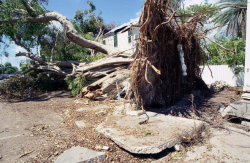I bought my two-story eye-brow house in Old Town Key West in February 1984. It was a wreck but that's another story. Since Feb 1984, I recall just three hurricanes actually striking Key West; Georges in September 1998, Wilma in October 2005 and now Irma in September 2017. As hurricanes, Georges was CAT II wind whose eye passed over the island, Wilma was CAT III storm surge that passed slightly north and northeast and Irma was CAT IV wind that passed 25 miles to the east. In each case, the homes of Old Town Key West, including mine, suffered only superficial structural damage. For the most part, damages suffered have been primarily from flying debris or falling trees. Why? How is it these wood framed homes from the late 1800's and early 1900's have survived the worst nature has to offer?
Georges
I was living in Washington, DC when Georges came through. I advised my 3 renters to evacuate but they declined. My house and neighborhood received minimal damage except from toppled trees. A top heavy poinciana in the SE corner of my front yard fell and crunched my front porch and front porch roof. Nothing structural but the renters were catatonic. Georges' eye passed directly over Key West, bringing Cat II winds but little in the way of storm surge. It took two weeks to return electric and reliable water service to Key West. Two weeks of heat and humidity and sweat. Food and water were delivered by the Red Cross.
I knew then and there to never entrust the Key West Tree Commissison with my safety as they had rejected multiple requests for a permit to remove the tree; aka, trees are more important than people. Only now, that the tree is down and had caused $10,000 in damages was I allowed to remove it. Georges left hundreds of toppled and damaged trees in its path across Key West. Many of them owned by the City.
Lesson Learned - TRIM YOUR TREES ANNUALLY. A lesson the Tree Commission ignores even for trees for which IT is responsible.
Wilma
I evacuated for Wilma and for one very good reason. Ever since moving to Key West I had heard that a storm coming into Key West from the north, especially the northwest, would be pushing a wall of water ahead of it. And the reason for the wall was because the water preceeding the storm would have no place to go. The string of islands comprising the Keys would block the water, turning the water into a wall higher and higher. Sure enough.
Two separate walls of water rolled over 80% of the island, flooding homes and businesses with 3' - 8' of water. The water receeded quickly enough (didn't hang around like Katrina or Harvey) but the damage was done. EXCEPT for my neighborhood as Old Town is situated just enough above sea level to be in an X-rated Flood Zone. My area received zero flood surge.
Irma
I evacuated for Irma. It followed a path nearly identical to Georges and I wanted to neither endure the hit nor the aftermath. Sure enough, despite Irma's Cat IV winds my house and neighborhood went virtually unscathed. The shingle roof of galvinized aluminum a certified roofing contractor installed in 2000 held firm. Basic but bolted shutters held fast and protected non-storm rated double hung sash windows. My well trimmed, 50 year old Royal Poinciana allowed safe passage of 120 mph winds. I had a bunch of minor branches to pick up but my house was safe - just like most of the homes in Old Town.
But why? My wood frame home was built in 1925. Most others in my neighborhood date likewise. What is it about these tightly packed, unassuming looking homes that offers such resilance?
Original Construction
Dade County Pine
The homes built in Old Town in the late 1800's to early 1900's were predominantly wood frame. The wood used was a now mostly non-existant wood called Dade County pine. This exceptionally hard wood is highly bug resistent and stands up well to the tropical climate. It will also chew up drill bits and bend many a muli-penny nail. It is not unusual for today's contractors to pull soft resin from the cores of the 12" x 12" support beams of floors and roofs while they are renovating homes.
Dade County Pine, or slash pine, has the scientific name of Pinus elliottii Engelm. The native geographic range of the typical slash pine variety includes the Coastal Plain from southern South Carolina to central Florida and west to eastern Louisiana. Slash pine has been planted as far north as Kentucky and Virginia , and as far west as eastern Texas, where it now reproduces naturally. The south Florida variety occurs in central and southern Florida and in the lower Florida Keys. I know of no Dade County pine presently growing in south Florida.
Original Construction
Mortise and tenon
Mortise and tenon is a building technique that is thousands of years old. The technique is basic, strong, flexible and, as it does not use nails, inexpensive. Each of these qualities was desired during the early 1900's, particularly the non-nail attribute as nails were expensive. The simple 90 degree design of early homes in Old Town was perfect for the existing wood boat building skill set of the sailor-carpenters who built these practical and durable homes. Dowels were often inserted into the joint as a strengthening device.
Mortise and tenon joints are little affected by the expansion or contraction of wooden members as a result of temperature and humidity changes. This "give" is ideal for Key West weather conditions and provides the stability needed in the gusty and shifting winds of a tropical storm.
Construction Today
For many years building code in Key West was whatever you could nail up over the weekend. Hurricane Andrew in 1992 and the exodus of insurance companies from Florida due to that Multi-Billion Dollar disaster dramatically changed that mindset. Florida now has some of the strictest building codes in the nation.
Old Town Key West also abides by significant direction given to maintain its historic architectural status. Therefore, renovation and restoration must merge building code AND architctural review. While these two tasks can sometimes conflict; aka modern building and Green techniques versus architectural preservation, by and large the combination of these two fields has resulted in exceptionally strong old homes. Additional good news is the private market is more and more building storm rated windows and doors and roofing material that adhers to the architectural preservation standards of historic communities like Old Town Key West. As such, architectural upgrades are simultaneously lowering windstorm insurance.
Conclusion
To be sure, hurricanes are a serious matter and you should think 2, 3, 4 times before you decide to ride one out. Be smart. Be safe. Also, be mindful that mandatory evacuation orders put you at a serious disadvantage when it comes to real time emergency services and legal positioning should you decide to stay.
If your home is situated in the Old Town area of Key West, congratulations. You have a sturdy home of historic and architectural significance. If reconstruction has been done recently or if you are contemplating a new roof, windows, edition, etc., be comforted that you will be getting what you pay for. However, don't give up your life and limb just because of.
Next up - indestructible roads, everlast electricity and constant flow fresh water. Maybe next year ...
Sister Louis Gabriel - Pray for us.
If you have any comments or questions, please contact me here.
Good luck!
Additional Resources:











